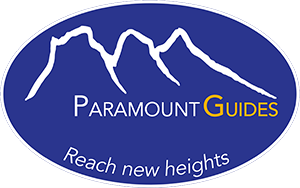Hazard, Safety and Risk Management
Quite often people want to know if the activity on which we are going to engage is completely safe and the short answer is no. Risk is an inherent part of mountain activities, and we can never eliminate it, but we can reduce it and make wise informed decisions that will enhance our safety practices.
To such goal, for us safety is paramount and approached in a systematic manner, that shape our policies, define our procedures, and drive our practices.
Also, to reach such goal our guides are not just sport professionals, but also, they are highly trained on risk management. Focusing during each program on identify hazards and managing risk to an acceptable level. This, as you can imagine, is a complex task that is done in a dynamic and often difficult environment. There is always a balance between meeting objectives without overly exposing people to high-risk factors.
We know that without challenge there is no rewards, but we strive to maintain the right balance between risk and reward and for positive outcomes. Our intent is to work in a controlled environment, not to control the environment.
Tolerance
Almost everyone has a different tolerance for risk. Someone new to the mountains may have a tolerance that is quite below that of someone who has been climbing or skiing for years. At the same time, a teaching or an introductory program may be operated with a very low tolerance for risk, compare to a private, goal-oriented day with an experienced client that has a relationship with the guide. All activities can be done in a relatively safe manner but there is less room for error when there is greater risk acceptance.
Responsibility
To be safe comes with shared responsibility between guides and guests, as it is the responsibility of everyone to think about what our risk acceptance is and how we convey that to each other. If anyone feels that the risk is unacceptable, they need to speak up and let that be known.
If one doesn’t understand nor is able to readily identify the hazards, then it is up to the guide to explain the hazards and the risk management of such hazards.
Typically speaking, the more uncertainty we are faced with the greater the risk appears.
Hazards in a mountain environment are a given. What we do and how we communicate risk management is integral to staying within our risk acceptance. This is a conversation that starts in planning the program and continues through to the end of the trip. Smart and informed decision making doesn’t guarantee safety, but it does make us safer. Here is when our release-of-liability waiver plays a key role to begin the conversation around such hazards and risk of an specific program.
If you are interested into learn more about our approach to hazard, safety and risk management, please keep reading:
At Paramount-Guides we manage risk through a multifaceted approach that begin with the planning to deliver programs and courses that are within our acceptable level of risk.
This is followed by Daily assessments considering factors such as weather, conditions, client profiles, energy, and skill levels to choose appropriate objectives and routes.
To continue with a Dynamic assessment which is the moment to moment with the guide making and implementing decisions (treatments) to enhance safety and optimize the level of risk in the field.
Assessing risk in a variable, multi-factor environment, meanwhile doing an activity is one of the most difficult tasks we all face in the mountain world.
Or in a simple graphics way to describe all the above, look at this simple square decision-making matrix.
The decision makers
Finally, critical to dealing with risk is having renowned guides and experts.
Guides at Paramount-Guides have undergone rigorous certification through the Association of Canadian Mountain Guides (ACMG) and the Canadian Avalanche Association (CAA). They also have a minimum first aid requirement of an 80-hour Wilderness First Responder course, recertified every three years, as well they comply with ACMG, CAA and IGA Scope of Practice regulations which requires mandatory yearly training to maintain adequate levels of knowledge and training.
We also like them to be personable and good educators, showing good judgement and excel at decision-making skills.
Other considerations
Risk management practices extend into all areas of our operations including gear, and compliance with Land Managers regulations.
Our Gear is rigorously maintained and serviced. Our rollover on gear is within the manufacturer’s recommendations so that we may continue to provide quality gear in great condition well within its serviceable life. We track and cycle through our ropes to ensure we know their history and age.
To begin, we need to recognize the hazards we face. Some are obvious such as steep terrain and rock fall meanwhile others are less obvious because their frequency is so low that we haven’t had much exposure to them.
Knowing the hazards then allows us to think about how we deal with them with our safety system in place.
The next step is to consider the likelihood of that event occurring, which is the hardest piece of the puzzle and most certainly a subjective expert-based assessment. Therefore, communicate and have access to peer information sharing services helps to avoid the subjectivity, allowing our guides to better determine the likelihood of the event.
We also need to consider the consequence or severity of that event occurring with our safety measures in place. Would it be of minor consequence or severe?
Finally, looking at our overall exposure to the event, we want to determine for how long we will be under that hazard, 1 minute or all day?
So, if we feel a risk is too high, we can reduce this through eliminating or avoiding the hazard and or, reducing the likelihood and or, reducing the consequence and or reducing our overall exposure.
In resume: Hazard Risk = Likelihood x Consequence x Exposure.





